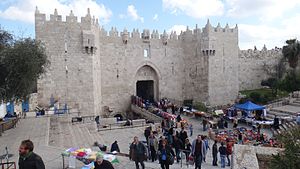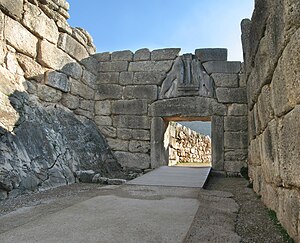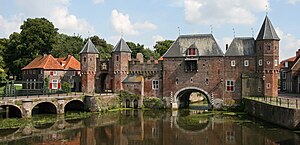City gate
This article needs additional citations for verification. (December 2009) |

A city gate is a gate which is, or was, set within a city wall. It is a type of fortified gateway.
Uses
City gates were traditionally built to provide a point of controlled access to and departure from a walled city for people, vehicles, goods and animals. Depending on their historical context they filled functions relating to defense, security, health, trade, taxation, and representation, and were correspondingly staffed by military or municipal authorities. The city gate was also commonly used to display diverse kinds of public information such as announcements, tax and toll schedules, standards of local measures, and legal texts. It could be heavily fortified, ornamented with heraldic shields, sculpture or inscriptions, or used as a location for warning or intimidation, for example by displaying the heads of beheaded criminals or public enemies.
Notably in Denmark, many market towns used to have at least one city gate mostly as part of the city's fortifications, but during the Age of Absolutism their functions become closely linked to the collection of customs, the so-called octroi, which from 1660 onwards was charged to the market town's coffers. When absolutism in Denmark came to an end after the revolutions of 1848, gate consumption was abolished in 1852, and since then the city gates also began to disappear.[1]
Medieval Danish city gates are found today only in Vesterport, Faaborg, and Mølleporten, Stege, as well as in Flensburg, today in Germany. Further city gates, in one form or another, can be found across the world in cities dating back to ancient times to around the 19th century. Many cities would close their gates after a certain curfew each night, for example, a bigger one like Prague or a smaller one like the one in Flensburg, in the north of Germany.
With increased stability and freedom, many walled cities removed such fortifications as city gates, although many still survive; albeit for historic interest rather than security. Many surviving gates have been heavily restored, rebuilt or new ones created to add to the appearance of a city, such as Bab Bou Jalous in Fes. With increased levels of traffic, city gates have come under threat in the past for impeding the flow of traffic, such as Temple Bar in London which was removed in the 19th century.
Examples
Africa
Asia
- China
- Zhengyangmen and Deshengmen in Beijing
- Gate of China in Nanjing
- city gate of Jianshui
- Cyprus: Famagusta Gate in Nicosia
- India
- Iraq: Ishtar Gate, Hillah
- Iran
- Qur'an gate (Shiraz)
- Nowbar gate (Tabriz).
- Israel: Gates in Jerusalem's Old City Walls
- Japan: Rashomon Gate, Kyoto
- Macau: Portas do Cerco - border gate for Macau with neighbouring Zhuhai
- Pakistan: Walled City of Lahore
- Philippines: Gates of Intramuros
- South Korea: Seoul's city gates, including: Namdaemun and Dongdaemun
- Taiwan: North gate of Taipei
- Yemen: Bab al Yemen of Sana'a
Europe
- Austria: Wienertor (1225/65): in Hainburg an der Donau
- Belgium:
- Brusselpoort: in Mechelen
- Waterpoort in Antwerp
- Halle Gate in Brussels
- Bosnia and Herzegovina: Višegradska kapija Višegrad gate, (also part of the old town of Vratnik) gate in Sarajevo
- Croatia: Walls of Dubrovnik
- Czech Republic:
- Powder Gate, Prague
- Písek Gate, Prague
- Zelená brána (Green Gate), Pardubice
- Brána Matky Boží, Jihlava
- Svatá brána, Kadaň
- Vysoká brána, Rakovník
- Pražská brána, Rakovník
- Denmark: Vesterport, Faaborg
- Estonia: Tallinn Gate in Pärnu
- France:
- Porte de Joigny and Porte de Sens in Villeneuve-sur-Yonne
- Porte de la Craffe in Nancy
- Porte des Allemands in Metz
- Porte Saint-Denis and Porte Saint-Martin in Paris
- Porte Mars in Reims
- Porte Cailhau in Bordeaux
- Porte de la Grosse-Horloge in La Rochelle
- Porte Mordelaise in Rennes
- Germany:
- Fünfgratturm in Augsburg
- Rotes Tor in Augsburg
- Vogeltor in Augsburg
- Wertachbrucker Tor in Augsburg
- Brandenburg Gate, in Berlin
- Eigelsteintor, Hahnentor, Ulrepforte, Severinstor in Cologne
- Nordertor, Kompagnietor and Rotes Tor in Flensburg
- Martinstor (Saint Martin's Gate) and Schwabentor in Freiburg im Breisgau
- Bayertor in Landsberg am Lech
- Holstentor, in Lübeck
- Isartor, Sendlinger Tor, Karlstor and Propylaea in Munich
- East Gate, in Regensburg
- Steintor, in Rostock
- Old Gate, in Speyer
- Porta Nigra, in Trier
- Greece: Lion Gate in Mycenae, 13th century B.C.
- Ireland:
- Saint Laurence Gate, Drogheda
- Sheep Gate, Trim
- St. James's Gate, Dublin
- gates of Dublin
- Italy:
- Porta Galliera, Bologna
- Porta Saragozza, Bologna
- Porta Paola, Ferrara
- Pusterla di Sant'Ambrogio, in Milan
- Porta Nuova (Medieval), in Milan
- Porta Nuova, in Milan
- Porta Ticinese (Medieval), in Milan
- Porta Ticinese, in Milan
- Porta Capuana, Naples
- Porta San Gennaro, Naples
- Port'Alba, Naples
- Porta Nolana, Naples
- Porta Felice, in Palermo
- Porta Nuova, in Palermo
- Porta San Giovanni, in Rome
- Porta del Popolo, in Rome
- Porta Maggiore, in Rome
- Porta Pinciana, in Rome
- Porta Tiburtina, in Rome
- Porta San Sebastiano, in Rome
- Porta San Paolo, in Rome
- Porta Camollia, Siena
- Porta Palatina, in Turin
- Lithuania: Gate of Dawn, in Vilnius
- Malta:
- Netherlands:
- Amsterdamse Poort, a city gate of Haarlem
- Waterpoort (water gate), Sneek
- Vischpoort (fish gate), Elburg
- Vischpoort (fish gate), Harderwijk
- Koppelpoort (combination gate), Amersfoort
- Zijlpoort (Eastern gate), Leiden
- Koepoort (Enkhuizen), Enkhuizen
- Drommedaris, Enkhuizen
- Sassenpoort, Zwolle
- Munttoren, Amsterdam
- Eastern Gate (Delft), Delft
- Groothoofdspoort, Dordrecht
- Koornmarktspoort, Kampen
- Poland:
- Brama Floriańska (St. Florian's Gate), Kraków
- Żuraw (Crane Gate), Gdańsk
- Brama Zielona (Green Gate), Gdańsk
- Brama Wyżynna (Highland Gate), Gdańsk
- Brama Mariacka, Gdańsk
- Brama Krakowska (Kraków Gate), Lublin
- Brama Mostowa (Bridge Gate), Toruń
- Brama Klasztorna, Toruń
- Brama Opatowska, Sandomierz
- Brama Młyńska (Mill Gate), Stargard
- Brama Pyrzycka, Stargard
- Brama Garncarska, Malbork
- Brama Lidzbarska (Lidzbark Gate), Bartoszyce
- Nowa Brama (New Gate), Słupsk
- Brama Świecka, Chojna
- Brama Wolińska, Goleniów
- Brama Odrzańska, Brzeg
- Brama Portowa (Port Gate), Szczecin
- Brama Górna, Olsztyn
- Brama Szczebrzeska, Zamość
- Portugal:
- Arco da Porta Nova (Arch of the New Gate), Braga
- Portas da Cidade (City Gate), Ponta Delgada (Azores)
- Portão dos Varadouros (Beaching Gate) a.k.a. City Gate, Funchal (Madeira)
- Romania: Catherine's Gate, Brașov
- Russia
- Slovakia:
- Michalská brána (Michael's Gate), Bratislava
- Košická brána, Levoča
- Spain: See Category:City gates in Spain
- Switzerland: The gates of the Basel City Walls, Basel
- Turkey

- Hadrian's Gate in Antalya
- The many gates in the walls of Constantinople, present day Istanbul
- Ukraine: Golden Gate, Kyiv
- United Kingdom:
- Bargate Southampton
- London's Roman and Medieval gates of the London Wall: Ludgate, Newgate, Aldersgate, Bishopsgate, Cripplegate, Moorgate, Aldgate
- Westgate, Canterbury
- Eastgate, Northgate, Watergate and Bridgegate. Chester
- The gates (known as Bars) of the York city walls
- Chepstow Town Gate, Wales
Americas

- Canada: Kent Gate, Prescott Gate, Saint-Jean Gate, and Saint-Louis Gate at the ramparts of Quebec City
- Peru: Machu Picchu's gate
- Trinidad and Tobago: City Gate (Port of Spain), Port of Spain
- Uruguay: Gateway of the Citadel
See also
References
- ^ "Byporte under enevælden" [City gates under the dictatorship]. web.archive.org (in Danish). 10 March 2016. Archived from the original on 2007-12-17. Retrieved 29 August 2022.
External links
![]() Media related to City gates at Wikimedia Commons
Media related to City gates at Wikimedia Commons
- CS1 Danish-language sources (da)
- Articles with short description
- Short description with empty Wikidata description
- Articles needing additional references from December 2009
- All articles needing additional references
- Articles using small message boxes
- Incomplete lists from February 2022
- Commons category link is locally defined
- AC with 0 elements
- City gates
- Types of gates















